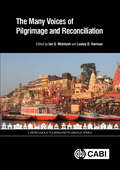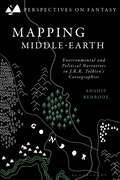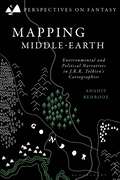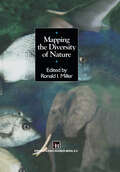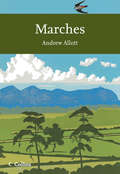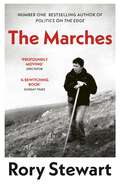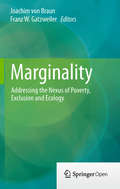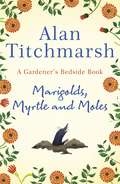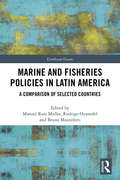- Table View
- List View
Many Voices of Pilgrimage and Reconciliation, The (CABI Religious Tourism and Pilgrimage Series)
by Tahar Abbou Lucinda Carspecken John Hornblow Jenny Boyack Sonika Jain Nanna Natalia Jørgensen Steven Muir Zülfükar Özdogan Cindy Pavlinac E. Moore Quinn Mari-Johanna Rahkala-Simberg Varada Sambus Patricia A. Sayre Daniel J. Simons Chadwick Co Su Sara TerreaultReviewing peace and reconciliation, secular pilgrimages, and international perspectives on sacred journeys, this book offers the reader an opportunity to encounter multiple voices and viewpoints on one of the most ancient practices of humankind. With an estimated third of all international travellers now undertaking journeys anticipating an aspect of transformation (the hallmark of pilgrimage), this book includes both spiritual and non-spiritual voyages, such as journeys of self-therapy, mindfulness and personal growth. It also: - Provides a multidisciplinary perspective, covering themes such as gender, human rights, equality, the environment, peace, history, literature, and politics - Reflects the rich diversity and multiple meanings of pilgrimage through an international writer team spanning four continents - Includes case studies of pilgrimage in action from around the world An innovative and engaging addition to the pilgrimage literature, this book provides an important resource for researchers of religious tourism and related subjects.
Maple tree (Large Print)
by Rnib BookshareIn this image of a maple tree, the trunk stems from the bottom centre of the page and the leafy branches are in the middle of the page. There is a locator dot shown, which will be at the top left of the page when the image is the right way up. There is a picture of a maple leaf in the top left and a picture of a maple seed in the top right of the page. The leaf stem is to the top right of the leaf itself. The seed is similarly positioned. For scale there is a 'stick man' representing the height of an adult person in the bottom right of the page. The field maple, native to England but not Scotland, rarely grows big enough for timber use. It is favoured for wood turning to make bowls. In the Middle Ages it was used for making musical instruments. It does produce syrup but it has a much lower sugar content than Canadian maple syrup. The seeds are paired and have wings enabling the seed to land at a distance from the mother tree. This small tree only lives for 50 to 100 years.
Maple tree (UEB Contracted)
by Rnib BookshareIn this image of a maple tree, the trunk stems from the bottom centre of the page and the leafy branches are in the middle of the page. There is a locator dot shown, which will be at the top left of the page when the image is the right way up. There is a picture of a maple leaf in the top left and a picture of a maple seed in the top right of the page. The leaf stem is to the top right of the leaf itself. The seed is similarly positioned. For scale there is a 'stick man' representing the height of an adult person in the bottom right of the page. The field maple, native to England but not Scotland, rarely grows big enough for timber use. It is favoured for wood turning to make bowls. In the Middle Ages it was used for making musical instruments. It does produce syrup but it has a much lower sugar content than Canadian maple syrup. The seeds are paired and have wings enabling the seed to land at a distance from the mother tree. This small tree only lives for 50 to 100 years.
Maple tree (UEB Uncontracted)
by Rnib BookshareIn this image of a maple tree, the trunk stems from the bottom centre of the page and the leafy branches are in the middle of the page. There is a locator dot shown, which will be at the top left of the page when the image is the right way up. There is a picture of a maple leaf in the top left and a picture of a maple seed in the top right of the page. The leaf stem is to the top right of the leaf itself. The seed is similarly positioned. For scale there is a 'stick man' representing the height of an adult person in the bottom right of the page. The field maple, native to England but not Scotland, rarely grows big enough for timber use. It is favoured for wood turning to make bowls. In the Middle Ages it was used for making musical instruments. It does produce syrup but it has a much lower sugar content than Canadian maple syrup. The seeds are paired and have wings enabling the seed to land at a distance from the mother tree. This small tree only lives for 50 to 100 years.
Mapping Antarctica: A Five Hundred Year Record of Discovery (Springer Praxis Books)
by Robert Clancy John Manning Henk BrolsmaEveryone likes maps and maps are always used to illustrate the many books on the Antarctic. Here the focus is reversed with contemporary maps telling the story – one that should be attractive to the widest audience as it is a unique approach complimenting what has gone before and providing something different for all interested in Antarctica.
Mapping Geomorphological Environments
by Kosmas Pavlopoulos Niki Evelpidou Andreas VassilopoulosMapping Geomorphological Environments is a highly descriptive textbook providing an excellent introduction to the latest methodologies for mapping geomorphological formations in a variety of different environments. Its holistic approach seeks to provide a meaningful linkage between state of the art techniques for geomorphological mapping, including the latest innovations in geospatial applications, and advances in the understanding of the formation of geomorphological phenomena in a variety of settings and environments. The book includes: - An introduction to the processes which form geomorphological formations and how to map them. - Case studies from a variety of environments with many examples of geomorphological maps. - In-depth descriptions of the latest tools and methodologies such as field sampling, GPS usage, 3–4D mapping, GIS analysis, digital image analysis, etc. - A list of the geomorphological characteristics per environment (e.g. coastal, fluvial, etc.) in the format of a geomorphological encyclopaedia, with pictures, maps and symbols. It covers the entire workflow ranging from data collection, analysis, interpretation, and mapping. Acknowledgements All authors would like to acknowledge the contribution of Dr. John W.M. Peterson, School of Computing Sciences, University of East Anglia, Norwich, UK, for corrections and improvement to the English text.. Università Telematica Guglielmo Marconi (UTGM) and ENEA acknowledge the collaboration of CUTGANA (Centro Universitario per la Tutela e la Gestione degli Ambienti Naturali e degli Agroecosistemi), Università di Catania, for the paper on "The Cyclops Islands". IRMCo acknowledges the use of the Integrated Land and Water Information System (ILWIS), developed by ITC, the Netherlands, for the management and assessment of geographic information in a GIS environment. ILWIS functionality was employed for the paper on "The natural heritage of the Island of Gozo" and the paper on "The geomorphological cave features of Ghar il-Friefet". IPB (Polytechnic Institute of Bragança) wishes to acknowledges all those colleagues, most of them also members of CIMO (Centre for Mountain Research), that contributed to the recently issued Management Plan of Montesinho Natural Park (PNM). Their hidden contribution to the articles concerning PNM is much acknowledged. A word in recognition of his endless and contagious enthusiasm towards Montesinho and to the Mountain domain, spread among us all in the IPB, is due to Professor Dionísio Gonçalves, the first Director, Coordinator and President of PNM, CIMO and IPB, respectively. The authors of the photos inserted in the articles concerning Montesinho are also much acknowledged for their contribution.
Mapping Global Dynamics: Geographic Perspectives from Local Pollution to Global Evolution
by Gilbert AhamerThis book asks: What are the most suitable “mapping strategies” for detecting patterns of global dynamics?It adopts a spatial perspective when trying to understand “Global Dynamics” – and sets out to revolutionise the concept of space as such. Spatial views – on levels of increasing abstraction, reflection and self-organisation – are developed along eight case studies including air emissions, environmental radioactivity, deforestation, energy from biomass, land use change, food supply, water quality and cooperative interdisciplinary learning for global change.This book’s conceptual innovation consists in performing a transformation from “space & time” into “functional state space & evolutionary time” in order to better recognise the structural patterns of long-term global dynamics. A transdisciplinary readership in academia – including geography, philosophy, economics, global change and future research – that is interested in enlarging scientific concepts beyond classical borders – would be most welcome!
Mapping Middle-earth: Environmental and Political Narratives in J. R. R. Tolkien's Cartographies (Perspectives on Fantasy)
by Dr Anahit BehroozIn this cutting-edge study of Tolkien's most critically neglected maps, Anahit Behrooz examines how cartography has traditionally been bound up in facilitating power. Far more than just illustrations to aid understanding of the story, Tolkien's corpus of maps are crucial to understanding the broader narratives between humans and their political and environmental landscapes within his legendarium. Undertaking a diegetic literary analysis of the maps as examples of Middle-earth's own cultural output, Behrooz reveals a sub-created tradition of cartography that articulates specific power dynamics between mapmaker, map reader, and what is being mapped, as well as the human/nonhuman binary that represents human's control over the natural world.Mapping Middle-earth surveys how Tolkien frames cartography as an inherently political act that embodies a desire for control of that which it maps. In turn, it analyses harmful contemporary engagements with land that intersect with, but also move beyond, cartography such as environmental damage; human-induced geological change; and the natural and bodily costs of political violence and imperialism. Using historical, eco-critical, and postcolonial frameworks, and such theorists as Michel Foucault, Donna Haraway and Edward Said, this book explores Tolkien's employment of particular generic tropes including medievalism, fantasy, and the interplay between image and text to highlight, and at times correct, his contemporary socio-political epoch and its destructive relationship with the wider world.
Mapping Middle-earth: Environmental and Political Narratives in J. R. R. Tolkien's Cartographies (Perspectives on Fantasy)
by Dr Anahit BehroozIn this cutting-edge study of Tolkien's most critically neglected maps, Anahit Behrooz examines how cartography has traditionally been bound up in facilitating power. Far more than just illustrations to aid understanding of the story, Tolkien's corpus of maps are crucial to understanding the broader narratives between humans and their political and environmental landscapes within his legendarium. Undertaking a diegetic literary analysis of the maps as examples of Middle-earth's own cultural output, Behrooz reveals a sub-created tradition of cartography that articulates specific power dynamics between mapmaker, map reader, and what is being mapped, as well as the human/nonhuman binary that represents human's control over the natural world.Mapping Middle-earth surveys how Tolkien frames cartography as an inherently political act that embodies a desire for control of that which it maps. In turn, it analyses harmful contemporary engagements with land that intersect with, but also move beyond, cartography such as environmental damage; human-induced geological change; and the natural and bodily costs of political violence and imperialism. Using historical, eco-critical, and postcolonial frameworks, and such theorists as Michel Foucault, Donna Haraway and Edward Said, this book explores Tolkien's employment of particular generic tropes including medievalism, fantasy, and the interplay between image and text to highlight, and at times correct, his contemporary socio-political epoch and its destructive relationship with the wider world.
Mapping Possibility: Finding Purpose and Hope in Community Planning (Routledge Equity, Justice and the Sustainable City series)
by Leonie SandercockMapping Possibility traces the intertwined intellectual, professional, and emotional life of Leonie Sandercock. With an impressive career spanning nearly half a century as an educator, researcher, artist, and practitioner, Sandercock is one of the leading figures in community planning, dedicating her life to pursuing social, cultural, and environmental justice through her work. In this book, Leonie Sandercock reflects on her past writings and films, which played an important role in redefining the field in more progressive directions, both in theory and practice. It includes previously published essays in conjunction with insightful commentaries prefacing each section, and four new essays, two discussing Sandercock’s most recent work on a feature-film project with Indigenous partners. Innovative, visionary, and audacious, Leonie’s community-based scholarship and practice in the fields of urban planning and community development have engaged some of the most intractable issues of our time – inequality, discrimination, and racism. Through award-winning books and films, she has influenced the planning field to become more culturally fluent, addressing diversity and difference through structural change. This book draws a map of hope for emerging planners dedicated to equity, justice, and sustainability. It will inspire the next generation of community planners, as well as current practitioners and students in planning, cultural studies, urban studies, architecture, and community development.
Mapping Possibility: Finding Purpose and Hope in Community Planning (Routledge Equity, Justice and the Sustainable City series)
by Leonie SandercockMapping Possibility traces the intertwined intellectual, professional, and emotional life of Leonie Sandercock. With an impressive career spanning nearly half a century as an educator, researcher, artist, and practitioner, Sandercock is one of the leading figures in community planning, dedicating her life to pursuing social, cultural, and environmental justice through her work. In this book, Leonie Sandercock reflects on her past writings and films, which played an important role in redefining the field in more progressive directions, both in theory and practice. It includes previously published essays in conjunction with insightful commentaries prefacing each section, and four new essays, two discussing Sandercock’s most recent work on a feature-film project with Indigenous partners. Innovative, visionary, and audacious, Leonie’s community-based scholarship and practice in the fields of urban planning and community development have engaged some of the most intractable issues of our time – inequality, discrimination, and racism. Through award-winning books and films, she has influenced the planning field to become more culturally fluent, addressing diversity and difference through structural change. This book draws a map of hope for emerging planners dedicated to equity, justice, and sustainability. It will inspire the next generation of community planners, as well as current practitioners and students in planning, cultural studies, urban studies, architecture, and community development.
Mapping the Diversity of Nature
by R. I. MillerThe diversity of life is displayed by a diversity the biodiversity elements. These unique of structural and functional elements. Many approaches are usually tailored to the region of aspects of this diversity are critical for main the world where the scientists' work is focused. taining the healthy functioning of biological This book presents accounts of many tech systems both within short and long time scales. niques that are currently being used in different Some highly diverse features of nature arise parts of the globe by conservation scientists. simply from the heterogeneous patterns that Many different techniques are necessary to comprise the web of nature. Many of these handle the differences in data types and data features contribute to the beauty and quality of coverages that occur across the globe. Also, a life. Humans do not yet understand enough variety of mapping approaches are needed about the complexity of nature to distinguish today to strengthen the many diverse critical those elements that act to support natural conservation objectives. These objectives include vitality from those elements that contribute the identification of the distribution patterns exclusively to our experience of beauty and for a species or habitat type and the placement quality in life. of protected area boundaries.
Mapping the Journey: Case Studies in Strategy and Action toward Sustainable Development
by Lorinda R. Rowledge Russell Barton Kevin Brady James Fava Cynthia Figge Konrad Saur Steven YoungThis illuminating new book presents a series of in-depth case studies from around the world based on numerous personal interviews with organizational leaders and focusing on their journey towards sustainability. The aim is to provide visions of a more sustainable future, and shed light on the path, milestones and solutions – in particular the management processes these organizations employed – to provide a reliable compass that others can follow. Although each organization must take steps to fit its particular circumstance, business conditions and culture, Mapping the Journey proves that valuable lessons can be learned by setting aside critique as to where these organizations may yet make progress and instead focusing on the guidelines, targets, measures of success, tools and techniques and valuable wisdom about how pioneer organisations are travelling toward a prosperous, sustainable future. Each organization included has crafted its own unique strategic responses to an identified need for increased sustainability. While none can be said to have reached the end-point of a sustainable development strategy, all have found that, by addressing the challenge of sustainable industrial practices, they have found innovative solutions, new opportunities for revenue generation, better relationships with customers, new business and product opportunities and a boost to morale from the executive ranks to front-line employees. Mapping the Journey examines both public and private organizations worldwide: SJ Rail of Sweden; Sony Corporation; SC Johnson; TransAlta Corporation; Patagonia; Henkel; Volvo; ASG; Interface Flooring Systems; Suncor; DaimlerChrysler; AssiDoman; Germany's Centre for Technology Assessment and the Dutch National Environmental Policy Plan. These case studies provide an inspiring framework of effective processes for defining a sustainable development strategy and transforming it successfully into actions and results.
Mapping the Journey: Case Studies in Strategy and Action toward Sustainable Development
by Lorinda R. Rowledge Russell Barton Kevin Brady James Fava Cynthia Figge Konrad Saur Steven YoungThis illuminating new book presents a series of in-depth case studies from around the world based on numerous personal interviews with organizational leaders and focusing on their journey towards sustainability. The aim is to provide visions of a more sustainable future, and shed light on the path, milestones and solutions – in particular the management processes these organizations employed – to provide a reliable compass that others can follow. Although each organization must take steps to fit its particular circumstance, business conditions and culture, Mapping the Journey proves that valuable lessons can be learned by setting aside critique as to where these organizations may yet make progress and instead focusing on the guidelines, targets, measures of success, tools and techniques and valuable wisdom about how pioneer organisations are travelling toward a prosperous, sustainable future. Each organization included has crafted its own unique strategic responses to an identified need for increased sustainability. While none can be said to have reached the end-point of a sustainable development strategy, all have found that, by addressing the challenge of sustainable industrial practices, they have found innovative solutions, new opportunities for revenue generation, better relationships with customers, new business and product opportunities and a boost to morale from the executive ranks to front-line employees. Mapping the Journey examines both public and private organizations worldwide: SJ Rail of Sweden; Sony Corporation; SC Johnson; TransAlta Corporation; Patagonia; Henkel; Volvo; ASG; Interface Flooring Systems; Suncor; DaimlerChrysler; AssiDoman; Germany's Centre for Technology Assessment and the Dutch National Environmental Policy Plan. These case studies provide an inspiring framework of effective processes for defining a sustainable development strategy and transforming it successfully into actions and results.
The Mar Chiquita Salt Lake (Córdoba, Argentina): Ecology and Conservation of the Largest Salt Lake in South America
by Enrique H. BucherThis book provides a comprehensive, updated syntheses of all the information available on Mar Chiquita, covering various aspects of the geography, geological history, biology and ecology of the site, as well as a detailed analysis of the current land-use patterns, environmental threats, and conservation issues. Mar Chiquita, located in the province of Cordoba, Argentina, is a protected wilderness area that includes South America’s largest saline lake and wetland. It has a very rich bird biodiversity, including three of the six species of flamingos that exist in the world, and high numbers of intercontinental migratory shorebirds. For this reason, the area has been declared an International Site by the Ramsar Convention on Wetlands of International Importance, and also a Site of Hemispheric Importance by the Western Hemisphere Shorebird Reserves Network. Largely unknown until very recently, particularly in terms of the English literature, the site is rapidly gaining international visibility, not only in terms of scientific research, but also as site of interest for the nature lovers around the globe. Written in a language accessible to the non-specialists, the book focuses on integrating the dynamic, functional processes in the ecosystem, while at the same time providing the necessary descriptive information. Accordingly, it is of interest to scientists from diverse disciplines interested in saline wetlands, as well as to students, managers, and the general public.
Marathon Mum: How one woman’s fight for mental health inspired a running revolution
by Rachel Brown Warren FitzGerald'It's the finish line, not the finish time.'In the late 80s, our Rachel was having a boss time as a podium dancer at the Pleasuredrome, Birkenhead. Fast forward several years and she's married, with the kids she's always dreamed of, but the body she's always dreaded. To make things worse, her husband Trevor begins to show his true controlling colours and Rachel blames herself, spiralling into depression. Until she discovers running. Buzzing from her epiphany, the 'Forrest Gump of the Mersey' is derided by Trevor, but catches the attention of some local women, all struggling and vulnerable in their own ways. These disparate women persuade Rachel to lead them in a running club, to get a bit of whatever she's on, where they all discover more than the mere chance to shed a few pounds in this burgeoning sisterhood. Dealing with the dark and many faces of depression with a refreshing lightness of touch unique to this working-class woman from the Wirral, Marathon Mum is an uplifting story of the healing to be found in community, and the corners we can turn when we push ourselves across the line.
Marches (Collins New Naturalist Library #118)
by Andrew AllottA complete natural history and the first large-scale survey of this unique part of the country.
The Marches: A Borderland Journey Between England And Scotland
by Rory StewartTHE NO. 1 BEST-SELLING AUTHOR OF POLITICS ON THE EDGERory Stewart explores his love for the UK in this account of history, memory and landscape as he traverses the the borderlands between England and Scotland.‘This beautifully written book is a haunting reflection of identity and our relationships with the people and places we love’ Daily MailHis father Brian taught Rory Stewart how to walk, and walked with him on journeys from Iran to Malaysia. Now they have chosen to do their final walk together along ‘the Marches’ - the frontier that divides their two countries, Scotland and England.On their six-hundred-mile, thirty-day journey - with Rory on foot, and his father ‘ambushing’ him by car – the pair relive Scottish dances, reflect on Burmese honey-bears, and on the loss of human presence in the British landscape.Travelling across mountain ridges and through housing estates they uncover a forgotten country crushed between England and Scotland: the Middleland. They discover unsettling modern lives, lodged in an ancient place, as their odyssey develops into a history of the British nationhood, a chronicle of contemporary Britain and an exuberant encounter between a father and a son.And as the journey deepens, and the end approaches, Brian and Rory fight to match, step by step, modern voices, nationalisms and contemporary settlements to the natural beauty of the Marches, and a fierce absorption in tradition in their own unconventional lives.‘Suggests an open-mindedness in Stewart, a tolerance and flexibility that could make him an exceptional politician while it also continues to define him as a writer’ New York Review of Books‘Travel writing at its best’ GuardianPlease note: The book cover received may differ from the cover displayed here.
MARE-WINT: New Materials and Reliability in Offshore Wind Turbine Technology
by Wiesław Ostachowicz Malcolm McGugan Jens-Uwe Schröder-Hinrichs Marcin LuczakThis book provides a holistic, interdisciplinary overview of offshore wind energy, and is a must-read for advanced researchers. Topics, from the design and analysis of future turbines, to the decommissioning of wind farms, are covered. The scope of the work ranges from analytical, numerical and experimental advancements in structural and fluid mechanics, to novel developments in risk, safety & reliability engineering for offshore wind.The core objective of the current work is to make offshore wind energy more competitive, by improving the reliability, and operations and maintenance (O&M) strategies of wind turbines. The research was carried out under the auspices of the EU-funded project, MARE-WINT. The project provided a unique opportunity for a group of researchers to work closely together, undergo multidisciplinary doctoral training, and conduct research in the area of offshore wind energy generation. Contributions from expert, external authors are also included, and the complete work seeks to bridge the gap between research and a rapidly-evolving industry.
Marginality: Addressing the Nexus of Poverty, Exclusion and Ecology
by Joachim Braun Franz W. GatzweilerThis book takes a new approach on understanding causes of extreme poverty and promising actions to address it. Its focus is on marginality being a root cause of poverty and deprivation. “Marginality” is the position of people on the edge, preventing their access to resources, freedom of choices, and the development of capabilities. The book is research based with original empirical analyses at local, national, and local scales; book contributors are leaders in their fields and have backgrounds in different disciplines. An important message of the book is that economic and ecological approaches and institutional innovations need to be integrated to overcome marginality. The book will be a valuable source for development scholars and students, actors that design public policies, and for social innovators in the private sector and non-governmental organizations.
Marginlands: Indian Landscapes on the Brink
by Arati Kumar-RaoA tour de force' – Robert Macfarlane'Some of the best environmental writing I have read' – Amitav Ghosh'Brilliant and evocative' – Pradip Krishen'Luminously written' – Paul Salopek'A book for the ages' – Ed KashiAN ENVIRONMENTALIST’S JOURNEY THROUGH INDIA’S PRECIOUS YET VULNERABLE LANDSCAPES.In the boundless Thar, deemed a ‘wasteland’ by the authorities, miners bulldoze sand dunes guarding life-sustaining water. The Gangetic dolphin, once a thriving apex predator, struggles for survival as its riverine habitat is fragmented by dams and roiled by incessant shipping. Deep in the mangrove forests of the Sunderban, tigers prey on desperate crab-catchers. Encroachments on the Mumbai coastline unleash cataclysmic floods. Along the eroding beaches of Kerala, fishers live in fear of the sea swallowing them whole. As the spectre of climate change compounds these natural and human-induced disasters, India’s most endangered landscapes are pushed to the precipice of destruction.Arati Kumar-Rao journeys to these marginlands, listening intently to their inhabitants, paying close attention to each fissure, fold and ripple, as she documents the misguided decisions, wilfully ignored warnings and disregarded evidence that have brought us almost to a point of no return. But the land is still rich in ancient wisdom, and its cracks hold lessons that may yet aid us in undoing centuries of slow violence – so long as one is willing to attune their senses.Combining enthralling nature writing and journalism with immersive art and photography, Marginlands is an urgent, vital work by a passionate chronicler of our environment.
Maria Thereza Alves: Seeds of Change
by Carin Kuoni Wilma LukatschIn an era of climate change, extractivist economies, and forced mobility, who and what belongs? Throughout her prolific career, Brazilian artist Maria Thereza Alves has focused precisely on this question. Perhaps her most iconic, generative, and expansive work is Seeds of Change, a twenty-year investigation into the hidden history of ballast flora—displaced plant seeds found in the soil used to balance shipping vessels during the colonial period. The project examines the influx and significance of imported plants, materializing at port cities across several continents: Marseille, Reposaari, Liverpool, Exeter and Topsham, Dunkerque, Bristol, Antwerp, and most recently New York, where it was awarded the Jane Lombard Prize for Art and Social Justice by the Vera List Center for Art and Politics at The New School. In each city, Seeds of Change has revealed the entangled relationship between “alien” plant species and the colonial maritime trade of goods and enslaved peoples, contrasting their seemingly innocuous beauty with the violent history associated with their arrival. By focusing on ballast flora, Alves invites us to de-border postcolonial historical narratives and consider a “borderless history.” The first monograph of Alves’s historic project, Seeds of Change is edited by Carin Kuoni and Wilma Lukatsch and features essays by the artist as well as Katayoun Chamany, Seth Denizen, Jean Fisher, Yrjö Haila, Richard William Hill, Heli M. Jutila, J. Kēhaulani Kauanui, Lara Khaldi, Tomaž Mastnak, Marisa Prefer, and Radhika Subramaniam.
Marigolds, Myrtle and Moles: A Gardener's Bedside Book
by Alan TitchmarshThe perfect bedside book for the green-fingered - hilarious and touching poems on a gardening theme written and introduced by the nation's favourite gardener and presenter of ITV's Love Your Garden, Channel 5's Secrets of the National Trust and with his own show on Classic FM.From touching poems on the peony, the snowdrop and the sweet pea to hilarious verse on Emily the Gardener and the Garden Design Course, this is Alan Titchmarsh's heartfelt and entertaining celebration of his favourite space - the garden.
Marine Algae: Biodiversity, Taxonomy, Environmental Assessment, and Biotechnology
by Leonel Pereira Joao Magalhaes NetoThis book is divided into three thematic areas. The first covers a revision of the taxonomy of algae, based on the algae portal, as well as the general aspects of biology and the methodologies used in this branch of marine biology. The second subject area focuses on the use of algae in environmental assessment, with an intensive implementation in W
Marine and Fisheries Policies in Latin America: A Comparison of Selected Countries (Earthscan Oceans)
by Manuel Ruiz Muller Rodrigo Oyanedel Bruno MonteferriThis book reviews the frameworks and implementation of marine, fishery and coastal laws and policies in Chile, Mexico and Peru. Chile, Mexico and Peru share biodiverse coastal and marine environments which are being affected by unregulated and informal developments, and thus share similar challenges. Each country is currently at a different stage of advancement in their institutional response to these complex challenges. By providing a comparison of the frameworks, approaches and overall implementation of policies and laws, this book acts as a tool to influence and inform further efforts in conservation and sustainable use of marine resources, particularly fisheries, in these countries and others in Latin America and the Caribbean. A broad range of issues are covered including food security, tourism, fisheries, oil and mineral extraction from the seabed, wind power, coastal and marine pollution and endangered species conservation. The chapters compare how each country addresses these issues from an institutional, legal and policy perspective. The book concludes by identifying common lessons, reoccurring challenges and develops scalable recommendations applicable to the case study countries and the wider region. The book will be of interest to advanced students, policy makers and researchers in marine and fishery science, law and policy.
